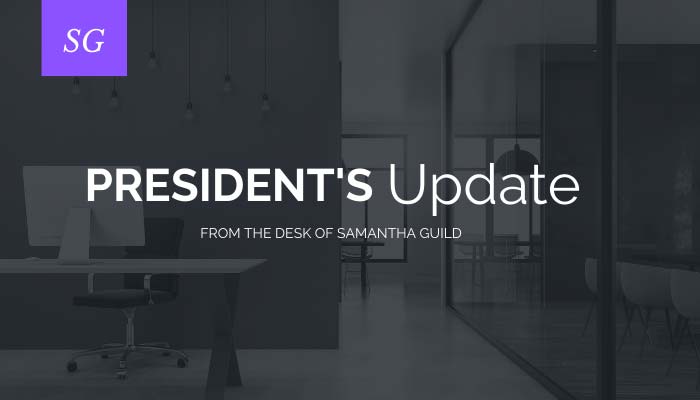President’s Letter | September 2022

From the Desk of Samantha Guild
Leaves are falling, pumpkins are out, football is on TV, and the kids are back in school…it’s fall!
This month’s newsletter features two compelling survivor stories: Please meet Erich Djordjevic and Bev Johnson. Erich is a Stage IV brain mets survivor, and Bev is a mucosal melanoma survivor. Thank you, Erich and Bev, for letting us tell your stories.
We’d also like to introduce you to two new AIM employees, Michelle Bessett and Ann Garst Taylor. Michelle is our National Director of Walks & Events, and Ann is our Director of Community Engagement. Many in the AIM community have already met them through one of our Walks, Peer Connect, or symposiums, and we can’t wait for more of you to meet these wonderful women. Read about both of them in this month’s newsletter. Welcome, Ann and Michelle! We’re thrilled you’ve joined us.
I know many of you were able to read our summer newsletter, which featured a long-form article on the State of Sunscreen in the U.S. If you didn’t get a chance to read it, I hope you will (here’s the link). It gives a clear and in-depth explanation of the reasons sunscreen has been in the news. As promised, I wanted to share some follow-up information. The National Academy of Sciences released their report on sunscreens and the environment, called Review of Fate, Exposure, and Effects of Sunscreens in Aquatic Environments and Implications for Sunscreen Usage and Human Health (2022). It’s a 400+ page document, so a summary is useful! AIM is part of a group called the PASS Coalition (Public Access to SunScreens), and this is an excerpt from the PASS press release about the NAS study:
The PASS Coalition applauds the National Academy of Science’ s objective and rigorous process and review of scientific research regarding the impact of sunscreens on public health and the environment.
Below are some key highlights from the report:
- Restrictions on certain UV filters may have negative impacts on the use of sunscreen to prevent skin cancer, sunburn, and photoaging if they lead to reduced sunscreen usage. The ability to purchase broad-spectrum, SPF 30+ sunscreen that people will actually use, is a key determinant of health outcomes, with increased use of sunscreen the scenario most likely to lead to positive effects on health.
- Environmental variables, including increasing temperatures, are of particular concern for aquatic ecosystems due to the potential for increasing cumulative and interacting impacts from climate change.
- The science on sunscreens is still evolving. Environmental exposure and hazard data on sunscreen ingredients are limited, and there is not widespread agreement about whether the available research sufficiently supports conclusions that individual ingredients have, or do not have, negative affect on aquatic organisms.
While there has been a push for bans of all non-mineral sunscreens in places like Hawaii, the NAS report states that there is currently insufficient data about the impact of sunscreens on aquatic environments and makes recommendations to the EPA for risk assessment parameters so that future studies can help determine any potential impacts.
Rich Gold, former Clinton Administration EPA official and senior advisor to the PASS Coalition, stated, “The report’s findings make clear there is a scientific consensus around the public health risk from sun exposure and the benefit from sunscreens. However, there is no scientific consensus at this point on the impact of sunscreens in the marine environment. As a former EPA regulator, I don’t think the data are there today to justify restrictions on the use of sunscreen in marine environments. To impose such restrictions today is to place hypothetical risk to the environment above known risk to human health.”
We will continue to update you on all news related to sunscreen. And please, remember our plea from the report we wrote: There are many sunscreen brands, formulas, and active ingredients on the market. The best sunscreen is the sunscreen you will use. Find a sunscreen you like, and use it!
We have some exciting news to share: We’ve recently partnered with a company called FreeWill to give the AIM community access to a free online estate planning tool. In about 20 minutes, FreeWill’s platform will guide you through each step of writing your will (or Revocable Living Trust if you live in California). We partnered with FreeWill after several AIM community members let us know that they wanted to include us in their estate plans, and we began investigating how to make it easier for them and others in the AIM community to do so. In this process, we learned that nearly 67% of Americans do not have an estate plan. No matter who you are, how old you are, or how healthy you are, having an up-to-date will is an essential way to protect your family and support charitable causes that are important to you. We hope you find this tool useful. Two of our employees have already used FreeWill to create their wills!
Another exciting announcement: AIM at Melanoma has been selected by No-Shave November as a benefiting foundation. No-Shave is a non-profit that raises funds for other cancer non-profits like AIM. In November, we will ask you to drop your razors, forgo those wax appointments, cancel the cuts, and donate all the proceeds you would normally spend on grooming to No-Shave November and pledge your fundraising efforts to AIM at Melanoma. The process is simple: all you need to do is visit no-shave.org and click donate > donate to nonprofit > and type our name in the search bar. We are thrilled to have been selected as part of the No-Shave family: Our participation allows us to reach a much wider audience with our prevention, early detection, and fundraising-for-research messages. Look for more information as we approach November!
Finally, please don’t miss the article in this month’s newsletter about a celebration in memory of my mother, Val Guild, during ASCO’s (American Society of Clinical Oncology) conference. She would have been humbled to know that 100 of the nation’s top melanoma oncologists gathered to remember and toast her and her work in the melanoma community. How I wish she could have been there.
Recent Posts

A Conversation with Dr. Rena Szabo, PsyD on Empowering Patients

Empowering Women in Melanoma: A Look Inside the Women in Melanoma Initiative

Melanoma News and Highlights You Don’t Want to Miss

Coping with Cancer: DBT Skills for Emotional Resilience


